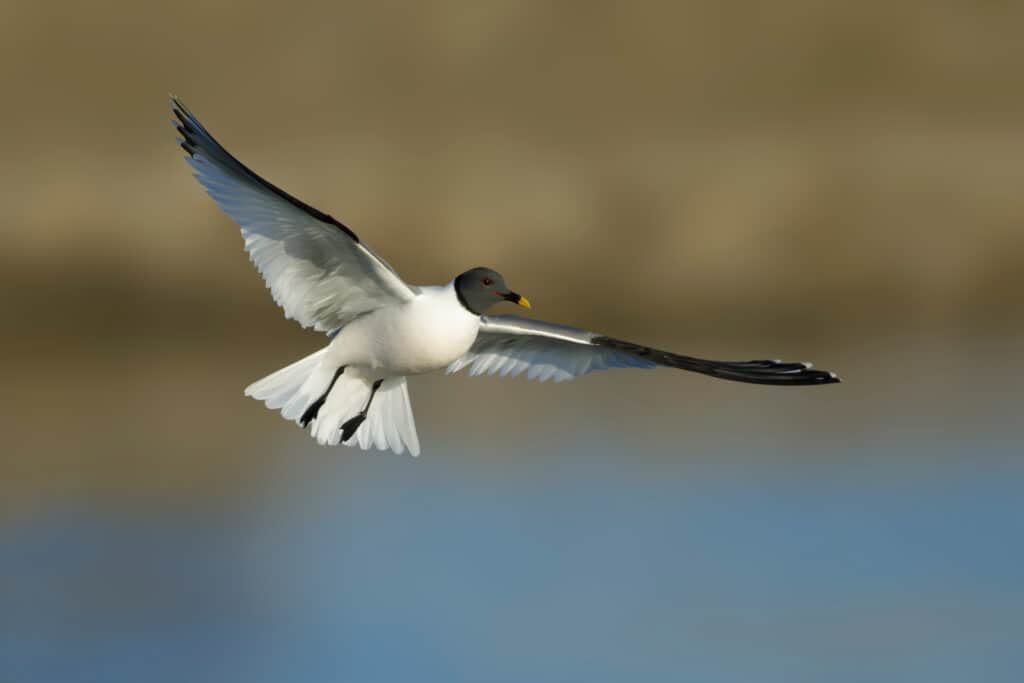Xeme (Sabine’s Gull)
Xema Sabini
They follow after seals and whales to eat their scraps.
Advertisement
Xeme (Sabine’s Gull) Scientific Classification
- Kingdom
- Animalia
- Phylum
- Chordata
- Class
- Aves
- Order
- Charadriiformes
- Family
- Laridae
- Genus
- Xema
- Scientific Name
- Xema Sabini
Read our Complete Guide to Classification of Animals.
Xeme (Sabine’s Gull) Conservation Status
Xeme (Sabine’s Gull) Facts
- Prey
- fish, crustaceans, insects, and offal
- Name Of Young
- Chicks
- Group Behavior
- Social
- Fun Fact
- They follow after seals and whales to eat their scraps.
- Estimated Population Size
- 2,000 to 2.1 million
- Biggest Threat
- Climate change, habitat loss
- Most Distinctive Feature
- long, pointed tri-colored wings
- Distinctive Feature
- Small heads, slender bill
- Wingspan
- 32 to 34 inches
- Incubation Period
- 23 to 25 days
- Age Of Fledgling
- one day
- Habitat
- Arctic tundra, marshy tundra near the coast
- Predators
- Peregrine falcons
- Diet
- Carnivore
- Lifestyle
- Diurnal
- Type
- Bird
- Common Name
- Sabine's gull
- Number Of Species
- 4
- Location
- North America, Europe
- Average Clutch Size
- 2
- Nesting Location
- On the ground on islands or the edges of ponds
- Age of Molting
- 2 years
- Migratory
- 1
View all of the Xeme (Sabine’s Gull) images!
“They live in the high Arctic, and sightings are prized for birders.”
Summary
The Xeme (Sabine’s gull) is a small gull found in North America and Europe. It lives in the Arctic during the breeding season, migrates over oceans, and spends winters in more tropical waters. You often find this bird flying low over the sea and wading in shallow ponds and tidal flats, foraging for insects and fish. This social species mate for life and spends much of the year in flocks. Discover everything there is to know about the Xeme, including where to find it, what it eats, and how it behaves.
5 Amazing Xeme Facts
- Xeme lives most of the year on Arctic tundra, where they breed and place their nests.
- They follow after seals and whales to eat their scraps.
- Groups occasionally gather to make displays and produce their squeaky high-pitched calls.
- Their young are born in advanced states and can feed themselves right after hatching.
- They sometimes rob other birds’ nests to eat their young.
Where to Find Xeme
The Xeme lives in North America and Europe in over 25 countries, including Iceland, Greenland, Canada, Russia, and Germany. They spend their springs and summers in the high arctic areas, migrate across oceans, and winter in warmer seas near coastlines. They inhabit the Arctic tundra during the breeding season and spend summers in marshy tundra near the coast, especially in areas with many ponds and tidal flats. This bird spends migration and winter mostly at sea, no more than a few miles offshore.
Xeme Nest
Sabine’s gulls breed on tundra and place their nests on the edges of ponds, islands in ponds, or marshy shore areas. They use shallow depressions in vegetation or gravel and occasionally line the insides with grass, algae, and feathers.
Scientific Name
The Xeme, or Sabine’s gull (Xema Sabini), belongs to the Laridae family, which includes seabirds like gulls, terns, and skimmers. It is the only species in the Xema genus and has four recognized subspecies.
Size, Appearance, & Behavior

The global Sabine’s gull population is estimated to number 2,000 to 2.1 million mature individuals.
©Agami Photo Agency/Shutterstock.com
Xeme is a small gull, measuring 10 to 13 inches long and weighing four to seven ounces, with a 32 to 34-inch wingspan. They have a small head, a slender bill, and long, pointed wings. Breeding adults are white with gray heads bordered in black. Their wings are three colors: gray wing coverts, black primary flight feathers, and white secondaries. They also have red eyering and black beaks with yellow tips. Nonbreeding adults have white speckles on their heads, and juveniles are brown with pale feathers edges, and all black bills.
The Sabine’s gull is relatively social, forming long-term mates and staying in flocks or groups during periods in the winter and spring. They forage around coastlines, and groups sometimes gather to display and make their squeaky high-pitched calls. Their flight is buoyant and similar to a tern. They produce deep wing beats as they fly low over the sea.
Migration Pattern and Timing
Xeme are short to long-distance migrants. They breed in high arctic regions, migrate over oceans, and winter in tropical waters. In North America, they spend springs and summers in the extreme northern areas of Canada and Greenland. They migrate over the Pacific Ocean, staying near the coastline, and winter off the coast of Mexico and Central America.
Diet
Sabine’s gulls are carnivores who forage on the surface of the water.
What Does Xeme Eat?
They eat fish, crustaceans, insects, and offal (fishing discards. During the summer, they mainly eat aquatic insects, larvae, crustaceans, small fish, mollusks, and marine worms. They may even eat eggs and nestlings from other birds and steal fish from Arctic terns. They walk along the edges or swim in freshwater pools, picking insects off the water and vegetation. This bird also hunts prey by shuffling its feet on the muddy bottom or spinning in circles to bring food near the surface. We don’t know much about their winter diet, except that they are more likely to scavenge. They will feed on small marine creatures that wash up on the shore and gather around seals and whales to eat their scraps.
Predators, Threats, and Conservation Status
The IUCN lists Sabine’s gull (Xeme) as LC or “least concern.” Due to its significant range and large, increasing population, this species does not meet the thresholds for “threatened” status. Their specific threats have yet to be evaluated, but they may suffer the effects of climate change, like habitat change and ecosystem shifts. They are also hunted in Russia, including egg harvesting.
What Eats Xeme?
The Xeme has very few natural predators. Their most significant threat in the wild is birds of prey, such as peregrine falcons. But their eggs and young are often well-concealed and camouflaged, preventing nest predation. However, if predators approach their nesting areas, adults will fake an injury, leading the creature away from their young. They may also dive-bomb intruders.
Reproduction, Young, and Molting
Sabine’s gulls form long-term monogamous pair bonds and return to the same nesting site every year with their mate. During courtship, males feed females, give long calls, and bow. Females will rub their heads and bodies against the male’s breast when they are ready to mate. Females lay one to three, an average of two, olive-colored eggs with dark spots. Both sexes take turns incubating the eggs for 23 to 25 days. Their young are born in an advanced state and can feed themselves shortly after hatching. They fledge the nest around one day old. The young become sexually mature and molt into their adult plumage around two years old. This species lives an average of six years but can live up to eight.
Population
The global Sabine’s gull population is estimated to number 2,000 to 2.1 million mature individuals. The European breeding population is between 2,000 and 2,100 mature individuals and appears to be increasing. This species is not experiencing any extreme fluctuations or fragmentations in its numbers.
Similar Animals:
View all 13 animals that start with XXeme (Sabine’s Gull) FAQs (Frequently Asked Questions)
Where do xeme live?
The Xeme lives in North America and Europe in over 25 countries, including Iceland, Greenland, Canada, Russia, and Germany.
How big is the Sabine's gull?
It is a small gull, measuring 10 to 13 inches long and weighing four to seven ounces, with a 32 to 34-inch wingspan.
Are xeme social birds?
They are relatively social, forming long-term mates and staying in flocks or groups during periods in the winter and spring.
Do xeme migrate?
Xeme are short to long-distance migrants. They breed in high arctic regions, migrate over oceans, and winter in tropical waters.
What does the Sabine's gull eat?
They eat fish, crustaceans, insects, and offal (fishing discards. During the summer, they mainly eat aquatic insects, larvae, crustaceans, small fish, mollusks, and marine worms.
What threatens the Sabine's gull?
Their specific threats have yet to be evaluated, but they may suffer the effects of climate change, like habitat change and ecosystem shifts. They are also hunted in Russia, including egg harvesting.
Thank you for reading! Have some feedback for us? Contact the AZ Animals editorial team.
Sources
- Red List / BirdLife International , Available here: https://www.iucnredlist.org/species/22694479/166280460
- JSTOR / Arctic Vol. 34, No. 2 / Sven Blomqvist and Magnus Elander, Available here: https://www.jstor.org/stable/40509127
- Oxford Academic, The Condor, Volume 103, Issue 1 / Iain J. Stenhouse, H. Grant Gilchrist, William A. Montevecchi, Available here: https://academic.oup.com/condor/article/103/1/98/5563116

















